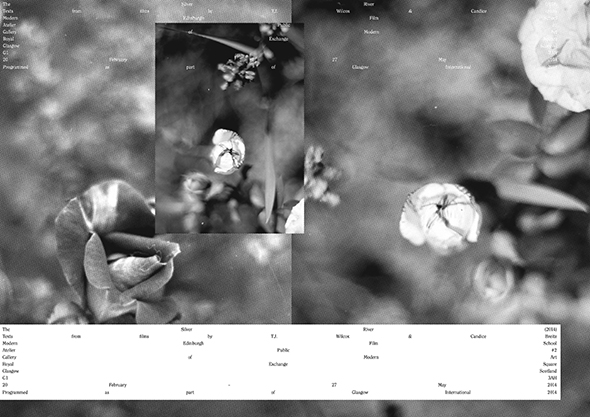
The Silver River, 2014, courtesy and © Modern Edinburgh Film School
Modern Edinburgh Film School, The Silver River
Alex Hetherington
Modern Edinburgh Film School is a title that summarizes my practice and interests. It scrutinizes a work or the ideas of an artist through him or herself. This scrutinization is done through the presentation of works or the making of a new work through dialogues, however they manifest, and through observing the audience seeing the work. I exist as a kind of editor and interpreter alongside this happening. It often occurs that I speak as an artist and an editor or critic at the same time. These editorial and artistic decisions progress or shape future events or publications; it is an evolving work. In that sense it reinforces an idea that I have about Modern Edinburgh Film School operating as multiple individuals, speaking harmoniously at one time with different voices.1
Modern Edinburgh Film School is an aesthetic, social and behavioural circumstance and has been variously described as: “drawing from simplicity to complexity”, and “a prism where one thing can be seen through another” – this has meant distributing and organizing events in different gallery sites in relation to their programs and purpose.
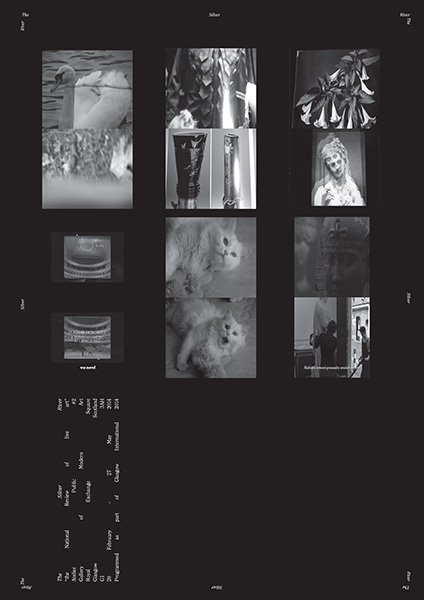
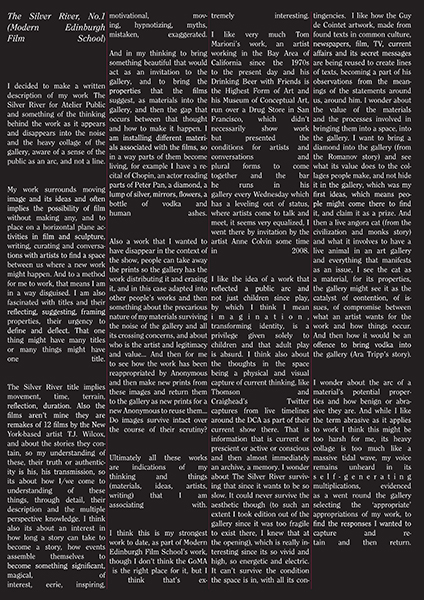
The Silver River, 2014, courtesy and © Modern Edinburgh Film School
The title is a disguise. Setting the work as an “institution” allows it to do more than I am capable of doing using only my own name. This pseudonym functions with acceleration and velocity, and has been able to create a “space” that allows it to inhabit different forms of collaboration and exchange. I am conscious of terms like instinct and intuition when working with artists.
The project stages the presentation of a new thing, with an identified collaborator representing a series of conversations – or sometimes an anonymous collaborator (e.g. Atelier Public 2) – where members of the public are invited to use certain materials to respond to, remake or reemploy elements from my work.2 Or at other times there is a referenced collaborator: I have published editions and works on Trisha Donnelly, Tom Marioni, Candice Breitz, T.J. Wilcox, and A.A. Bronson, among others. These editions or essays scrutinize and elaborate on their practices. They set up a kind of conversation with them or a kind of comparison—a relationship is created anyway, in all instances.
Modern Edinburgh Film School works with these forms: film, sculpture, screenings, writing, publishing, and distribution of editions set on a horizontal plane of activities. It is a title that has no gender. Its institutional identification is about confidence and enthusiasm. And on a practical level: a method, a praxis that helps me approach other artists or institutions with clarity and authority.
My editions are works that are made to disappear in their distribution (a stack of prints that leaves the gallery or my studio), from my hand to yours (folded up prints and posters on thin stock put into envelopes, sitting on piles of other things, put onto shelves and used as book marks, often thought of as “beautiful”). It constitutes a “library” and a “biography” and many of them are sent out to initiate a discussion, connection or participation but they rarely realize this objective. Meanwhile, titles of my screenings and events are documented as laser-etched black glass A5 sheets, which look like gallery invitations or film titles. There are 30 or so printed editions, while there are 12 black glass panels. This work is concerned with duration, a slow operation, a note played for a longer time.
Modern Edinburgh Film School has produced works through two years, sustaining itself through different funds and awards. The first year concentrated on clusters of frequent events, group shows and published works and felt like a season of works at different gallery spaces. It began with a screening about women artists from which I have learned about the moving image, including Catherine Sullivan and Daria Martin and a group show on the theme of poetry and documentary by emerging artists like Michelle Hannah, Christian Newby and Stina Wirfelt. Other works through the year had enigmatic titles like 6000 Posters for Giants and Dwarfs and Hold This Object Up Until There is Nothing Left of You, and a screening of 16mm films by Ute Aurand, she herself coming to the city from Berlin to present her films.
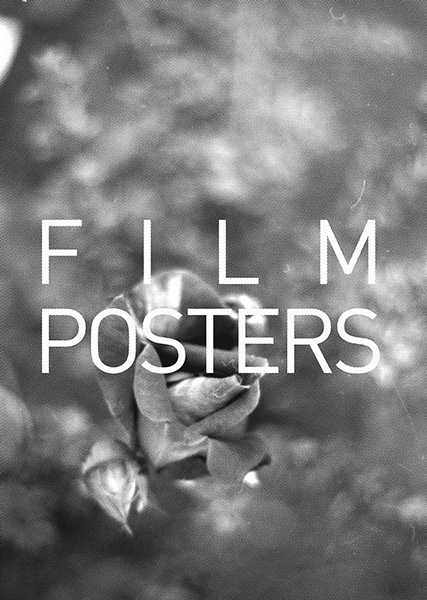

The Silver River, 2014, courtesy and © Modern Edinburgh Film School
The second year has been devoted to a single investigation called The Silver River, which was presented at Gallery of Modern Art in Glasgow (GoMA), a work staged inside and reflecting on Atelier Public 2.3 This work consisted of a series of prints that were made to disappear into the gallery and into other people’s collages. Twelve videos played on a loop on a monitor. Suggestions of objects and properties from the videos that related to their narratives, substances like vodka, diamonds, human ashes, a debt collector, swans’ feathers, live cats, a musical recital faintly heard, and a performance by the artist and actor Helen Cuinn who played a female “Peter Pan” reading Peter Pan, were brought into the gallery to subtly change its atmosphere. To make slight interventions, make questions about visibility, worth, value or practicality and consequences. Questions arose about the practicality or legality of bringing vodka to a gallery or having live cats wandering about artworks. These propositions articulated ideas of anonymity and authorship.
Later still and evolving from the GoMA work The Silver River became a new written edition and performance that featured a prop from Atelier Public: an appropriated text work by the late Guy de Cointet, a French-American artist who died in the late 1980s and who worked out of Los Angeles. This publication, called “A new island forming a fighting island, its surfacing painful from freezing, unfathomable waters”, says, “the reality diagonal”, itself a floating cinema, and a cathartic event, was made for a series of short-lived events and projects organized by Embassy Gallery in Edinburgh. The edition featured interviews between artists and filmmakers Leah Millar, Rebecca Green, Roween Suess, Laura Edbrook, Katrina Valle, Suzanne van der Lingen, and two artists who wished to remain anonymous.
Atelier Public Aesthetics and Materials, Some Observations
Atelier Public is a device for reading the minds of the public. It is evidence of the outside world and its current affairs from people willing to share something, to have a willingness to leave a mark. I see it as a subversive proposal where curating, and its forms of comparison, juxtaposition, protection or preservation, illumination and clarification, becomes live – electric live. The responsibilities, if that’s the correct term, are handed from the official curator to members of the public. The fabric of the gallery walls and the modes of operation of the public institution become its material, self observing. It becomes its own studio and decision maker. Its navigation and properties, as it became more cluttered and overlapping and a collage sculpture environment, was like reading a script or a mashed-up, cut-up newspaper written by a collective or production team making live film or theatre. The gallery had artists as performers, as directors, as audience. It was a sort of public record and a witness of its own contingencies and chaos.
The gallery is adorned with multi-coloured vinyl, a harsh adhesive material, easily manipulated and shaped. Over the course of the show I realise I could see through this material, or chose to ignore it, immune to its drama. Or I accepted its aesthetic and worked with its meanings. The vinyl becomes transparent and I chose to look at its content, at possible external stimulus and how people were responding, the residue from the outside world. Images from the conscious and unconscious. Some declarations of meaningful love, affirmations on a local and global scale, affirmation of presence and memorializing, special attention to artistic skills and talents, the raw energy of collaging, overlapping scenarios and borrowed ideas, haphazard mobiles, image making as marked territories, lots of cats and some anger, and stories about people you are unlikely to ever know.
I think the vinyl is grotesque. Its rainbow of colors aggravates my monochrome publications and careful image and text settings. But I would argue that both are just styles and looking beyond the material is an opportunity to focus on meaning (simulation, open capture, caption and invitation). Truth be told, I think it is something that should only ever be used for text, but it serves the function here unbelievably well, because it is so easy to order, use, reorder, manipulate, make, devalue, and discard. It imitates temporality and temporariness, and it only ever has or holds the worth of what it is asked to say. I wondered about allowing my reticent aesthetic to disappear into this disarray and seeing if it could survive.
The artist and performer Helen Cuinn and I had great conversations about the gallery as a site for performance, conversations about storytelling and making stories that allow parts of themselves to leave the screen, theatre, gallery, or television. She talked about portrayal and character, about certain kinds of behavior between the artist and the audience, about the “presence” of live performance. I asked her to come the gallery and read Peter Pan. Her costume and the way she wore her hair was like someone who had escaped a Disney film and had an aesthetic of innocence and newness that resonated with the science fiction/fantasy show downstairs, Aleksandra Domanovic’s work that looks at technology through a gender-conscious lens with layers of vast vinyl, super-glossy renditions of machines from science fiction films or Disney fairy stories.
I found Atelier Public wonderful to navigate with Helen Cuinn as my guide, allowing her to help me “find” the show through her performance (which was almost invisible and hardly announced) through her aesthetic choices, bold primary colors like the vinyl, and through my understanding of her conscious mind – reading the book Peter Pan. She became a kind of navigator, interpreter, or editor of Atelier Public, based on a fictional account of it, a Disneyfied version of it.
Watching her performance was liking watching a ghost materialize in the gallery: part of the space but entirely with her own timeline and frame of reference, secret but on display, partially present, but also occupying another world, a materialization of some of the space’s aesthetics (something about it having a child-like quality) appealing and innocent, drifting in and out of meaning, drawing into and out of a private world, but one which has universality.
This idea of recording the conscious mind reminds me of a presentation at artist Lindsay Mann’s symposium on the voice during the Edinburgh Film Festival, part of her Ph.D. at Edinburgh College of Art. Dr. Andrew Irving at University of Manchester, a social anthropologist, showed videos of people walking the streets of Manhattan recording the stream of consciousness of their thoughts through a microphone headset, followed by a steadicam video operator and how much of these recording were navigations and observations on social spaces and environments stimulating their thinking overlapping with the narrative of the individuals in the videos’ current concerns: things to do, issues, ruminations on recent hurtful experiences, future and past and present unfolding in real-time: subjects uppermost in their thinking, live happenings and stimulus affecting that thinking. In turn the mind, as it works internally and externally, presenting itself as reality.
I think Atelier Public does this; it is a recording device for capturing real-time thought, a memory depository for a collective individual, a story telling place. It is that essence that brings about or is abrasive to The Silver River, an action alongside and within this show, a studio work made partly visible and watching something like it, my work, be consumed by this public tornado.
The Silver River
The materials for The Silver River were sourced and produced during the development period for Atelier Public, which included a series of discussions with the other artists involved in the exhibition.
The Silver River is a two-way reflecting mirror, to its audience and also to me, and to the artist the work references. The two-way mirror also looks at the audience looking at or appropriating the work. The piece is an appropriation in itself and takes its cues from a series of 16mm film works collectively called Garlands by the New York-based visual artist T.J Wilcox. The materials represent a fascination with different kinds of stories from all walks of life that have a kind of magical reality to them. They reveal a strange perspective, an odd persona, or eye. In telling these stories and in their narration they tell another larger story, which is more about the narrator, about Wilcox, how he sees the world, his intentions, his ideas, his perception, his view of the world, and the things he needs to say. In me retelling his films, I am describing him.
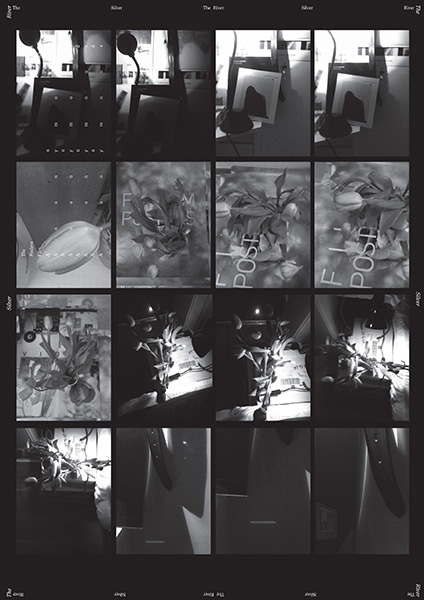
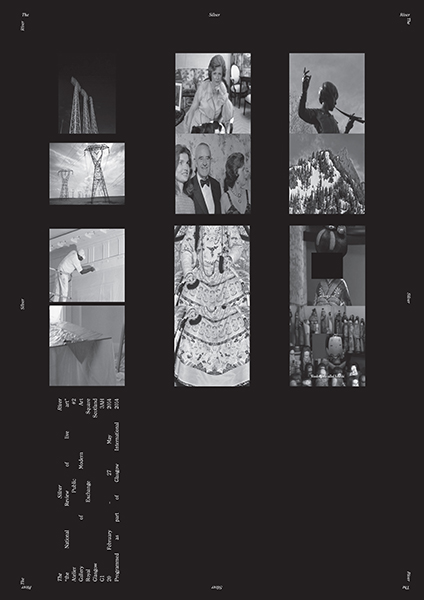
The Silver River, 2014, courtesy and © Modern Edinburgh Film School
His films narrate different kinds of stories that meld documentary and its visual conventions with fairy stories and mythologies and simple beautiful observations: shock, elegance, mystery, obscurity, the poignant, and absurd. The stories include the assassination of the Romanovs during the Communist Revolution in Russia, a woman who believed she could telepathically communicate with swans, an American ambassador killed at the height of her social and political power, the premature death of a mother, her ashes to be scattered across continents in magical meaningful places, including Peter Pan Garden in London, the composer Chopin’s last moments, and the story of La Comtesse, a Spanish aristocrat exiled in Paris who had thousands of photographs of her commissioned before becoming a recluse as her beauty faded.
The Silver River forms an aesthetic and conceptual relationship between me, Wilcox and the public. That this relationship would start to disappear into it, and that only traces would remain, and that these traces would be a series of anonymous collaborations, self generating, in a series of anonymous cycles, the prints and the films and the stories just slowly, slowly fading.
I wrote this about The Silver River: “That one thing might have many titles or many things might have one title. The Silver River title implies slow movement, time, reflection, duration, disappearing, film… it’s about an interest in how long a story can take to become a story, how events assemble themselves to become something significant, magical, of interest, eerie, inspiring, motivational, moving, hypnotizing, mistaken, or exaggerated”.
Modern Edinburgh Film School, The Silver River and its appearance at GoMA stages my work as an artist with curating, producing collaborative projects, publications and critical writing that work together on a theme of learning about selected moving image artists and their films and how they can be perceived.
July 2014, edited August 2014, Edinburgh, Scotland
_
1 For more information on Modern Edinburgh Film School
2 The first Atelier Public was conceived in 2011 as a small space within Glasgow’s Gallery of Modern Art (GoMA). In it, the public and a selected group of artists, makers and thinkers were invited to inform and shape an installation created by visitors over a 10-week period. Because the response to the exhibition was so positive, there was an interest continuing the process of experimentation that had begun. This second experiment in curating in public with artists was called Atelier Public #2
3 For more information on GoMA



